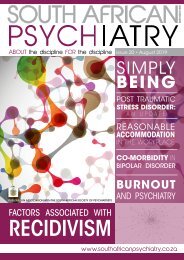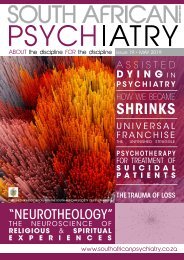South African Psychiatry - February 2019
South African Psychiatry - February 2019
South African Psychiatry - February 2019
Create successful ePaper yourself
Turn your PDF publications into a flip-book with our unique Google optimized e-Paper software.
FEATURE<br />
Neurosis, Freud argues, is the result of a fracture in the<br />
ego’s relationship with its broiling, immoral id while<br />
psychosis is indicative of a warring faction between<br />
the ego and the external world. In neurosis, the ego<br />
avoids the internal pressure exerted by a powerful<br />
wish through repression. The forbidden desire,<br />
however, struggles against this fate and a sign to the<br />
forgotten is created as a compromise. In psychosis,<br />
we witness not only the refusal of new perceptions<br />
from external reality but also the decathexis of the<br />
memory store of lived experience so that it loses its<br />
significance and can no longer be of use. There<br />
is a cost both ways says Freud (1924). A neurosis<br />
contents itself with replacing a piece of reality with<br />
a fantasy which attaches itself to a current situation<br />
lending it a hidden meaning, whereas in psychosis<br />
the ego interrupts its relationship with reality to<br />
the point where a new imaginary world is created<br />
in accordance with wishes as a substitute which<br />
can be patched over the original breach as if it<br />
originated from the outside.<br />
NO ONE WHO TOOK THE STAND DURING<br />
THE ARBITRATION APPEARED TO SUFFER<br />
FROM A PSYCHOTIC DISORDER IN<br />
THE WAY DESCRIBED BY FREUD. IT<br />
IS EQUALLY DIFFICULT TO VIEW THE<br />
MARATHON PROJECT AS A NEUROTIC<br />
PROCESS. YET, THE REALITY TESTING AND<br />
JUDGEMENT OF THOSE IMPLICATED<br />
IN THE DECANTING ALLOWED NEARLY<br />
ONE HUNDRED AND FIFTY PEOPLE WHO<br />
COULD NOT ADEQUATELY TAKE CARE OF<br />
THEMSELVES TO DIE DAILY AND CRUELLY<br />
ON THEIR WATCH. HOW CAN WE BEGIN<br />
TO UNDERSTAND THIS?<br />
In Negation (1925), Freud argues that the earliest<br />
developmental process the infant negotiates<br />
rests on two levels of judgement. The first of these<br />
relates to a fundamental and spontaneous sensory<br />
and visceral process of determining whether an<br />
experience feels good or bad.<br />
TO PARAPHRASE FREUD, IF WE WERE TO<br />
EXPRESS THIS IN THE LANGUAGE OF THE<br />
OLDEST ORAL INSTINCT, THE JUDGEMENT<br />
WOULD READ AS FOLLOWS: ‘THIS<br />
TASTES GOOD. IT IS GOOD AND SWEET.<br />
I WOULD LIKE TO TAKE THIS IN. IT SHALL<br />
THEN BE INSIDE ME. I WANT TO BE THAT<br />
THING. I BE THE GOOD THING. IT IS ME.’<br />
OR, ALTERNATIVELY: ‘THIS TASTES BAD. IT<br />
IS BAD AND BITTER. I NEED TO KEEP THIS<br />
OUT. I WILL SPIT IT OUT. IT SHALL THEN BE<br />
OUTSIDE ME. I DO NOT WANT TO BE<br />
THAT THING. IT IS NOT MY BAD. IT IS NOT<br />
ME.’<br />
THIS NEGATION ARGUES MARILIA<br />
AISENSTEIN (2017) “IS NOT MERELY A<br />
REFUSAL, BUT THE ROOT OF THE SUBJECT.<br />
THE INITIAL “NO” IS A REJECTION WHICH<br />
DISTINGUISHES THE INSIDE AND THE<br />
OUTSIDE AND BRINGS THE “I” INTO BEING.<br />
SAYING “NO” IS FIRST AND FOREMOST AN<br />
AFFIRMATION OF IDENTITY” (P. 204). AN<br />
INFANT INITIALLY ALLOWED THE PRIVILEGE<br />
OF SAYING NO IS POTENTIALLY ABLE TO<br />
INHABIT HIS SKIN AND EMBODY A SENSE<br />
OF SELF.<br />
In these early stages of making a mind a ‘purified<br />
pleasure ego’ is shaped by incorporating that which<br />
is gratifying, nurturing and exciting and ejecting all<br />
unpleasure, discomfort and frustration.<br />
THIS OMNIPOTENCE IS PROTECTIVE<br />
EMOTIONALLY, PSYCHOLOGICALLY<br />
AND COGNITIVELY FOR THE NEWBORN.<br />
IT IS CHARACTERISED BY A STATE OF<br />
UNDIFFERENTIATION.<br />
There is a definitive mix up between experiences<br />
in the form of bits and pieces which belong in<br />
an interior space and those which originate in<br />
an external one: a me and a not-me, and, more<br />
significantly, an illusion of a good me and a bad<br />
not-me. Judgement of experience is based on what<br />
feels good or bad regardless of whether external<br />
events align with the internal landscape. The baby<br />
may very well be wired to attach to caregivers and<br />
make sense of the environment neurologically but<br />
this does not mean that the status quo is being<br />
represented in the mind accurately in terms of<br />
objects and reality being separate and distinct.<br />
THE INFANT TAKES GOOD FROM SUPPLIES<br />
IN THE WORLD OUTSIDE AND, THROUGH<br />
IDENTIFICATION, MAKES THESE PART OF<br />
THE SELF AS IF THE GOOD THING WERE<br />
NEVER OUTSIDE TO BEGIN WITH. THE<br />
‘BAD’ IS SPAT OUT AND ALL THAT IS SPAT<br />
OUT IS PERCEIVED AS BELONGING TO A<br />
DIFFUSE NOT-ME ENVIRONMENT. “WHAT<br />
IS BAD, WHAT IS ALIEN TO THE EGO AND<br />
WHAT IS EXTERNAL ARE, TO BEGIN WITH,<br />
IDENTICAL” (FREUD, 1925, P. 369).<br />
It is because the antithesis between subjective<br />
and objective does not exist initially that our first<br />
experience of the world is confused and draws<br />
sustenance from the realm of wishes and affective<br />
storms. Yet it is essential that the infant is not aware of<br />
this paradox. Of course, this early forging of mental<br />
solids is an illusion. The reality is that what is spat out<br />
begins to assemble as the primitive superego in an<br />
SOUTH AFRICAN PSYCHIATRY ISSUE 18 <strong>2019</strong> * 19
















